Women in Business:
A Look at Female Business Leaders

Table of Contents
Women Rising
Working women, ever wonder if you’re getting anywhere?
Consider this: In 1973, Katharine Graham was the only female CEO of a Fortune 500 company.
The only one.
Well-educated but with zero business training and precious little journalism experience, she became publisher of the Washington Post in 1963. Over the next three decades, she faced down politicians, personal threats and striking printers to lead the family-owned paper through some of its toughest times. Along the way, she grew the Post Co. into a billion dollar business.
We were so intrigued by Graham’s personal story (she took over the paper when her husband committed suicide) that we had to include her in our new Women Rising infographic. It’s a snapshot of women in the workforce today—including the progress they’ve made, the roadblocks they face, and a stirring roundup of all the “Monday motivation” you’ll ever need.
Share this Image on Your Site
Women in the Workforce
By many measures, it’s a great time to be a woman in business:
- Today, there’s a better than 50% chance that your manager at work is female.
- There are more women in the workforce than ever before:
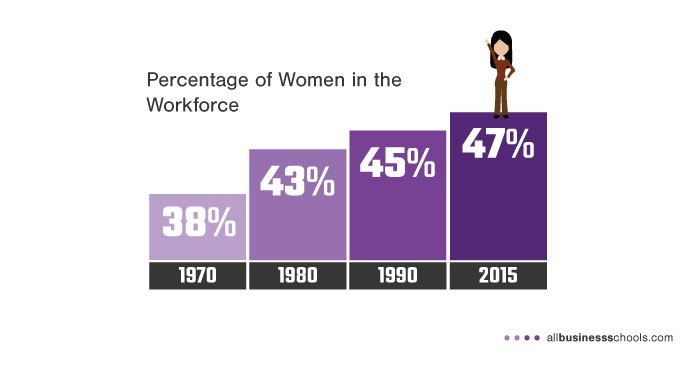
- And women are now better educated than men:
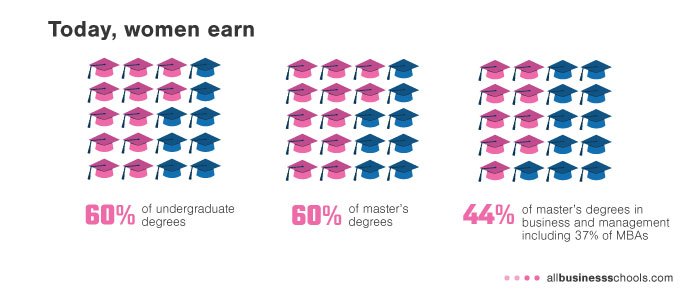
- For the first time ever, women are the sole or primary breadwinners in four out of ten U.S. families.
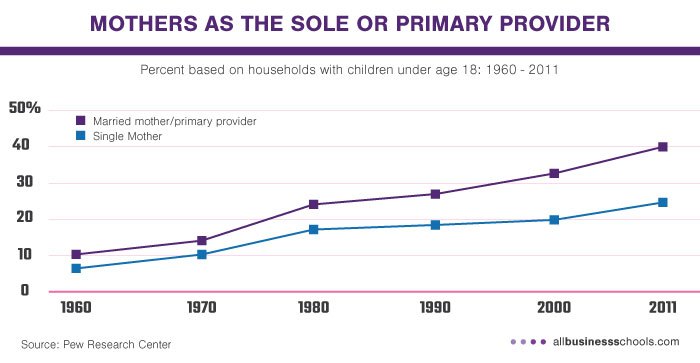
- Thanks to high earners like Beyoncé and actress-turned-entrepreneur Jessica Alba, businesswomen are more visible than ever.
- The number of women CEOs of Fortune 500 companies hit an historic high in 2022 (46).
Still, what image comes to mind when you hear the phrase “business leader”?
Is it a white male in a suit?
If so, it’s no wonder. Our culture still tends to equate stereotypically “masculine” traits—decisive, aggressive, closed—with leadership qualities.
And we’re surrounded by images that reinforce this association. (Try a Google image search on the term “business executive” or “business leader” and watch as a gallery of gray-suited men fills your screen.)
The conditioning starts early. As reported in the Guardian, the Geena Davis Institute analyzed all the G-rated films made between 2006 and 2009 and discovered that men were four times more likely than women to be portrayed as working professionals. Never mind reality: In those years at the movies, young audiences (and their families) saw no women in the fields of law, medicine, politics and executive leadership.
Unequal Pay, Unequal Voices
Despite decades of real progress in school and work, women’s pay still lags behind that of men. Overall, females in the U.S. workforce earn 83 cents for every dollar a man earns. For women of color, the situation is even bleaker: African American women earn 64 cents to a man’s dollar; American Indian women, 59 cents; and Latinas, just 57 cents.
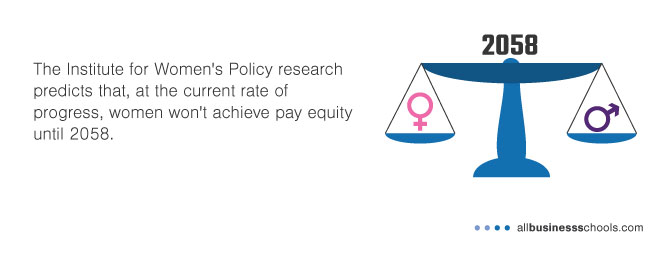
Women are under-represented at the highest levels of business and in government. They are 57.4% of the U.S. workforce, but lead just a small fraction of S&P 500 companies:
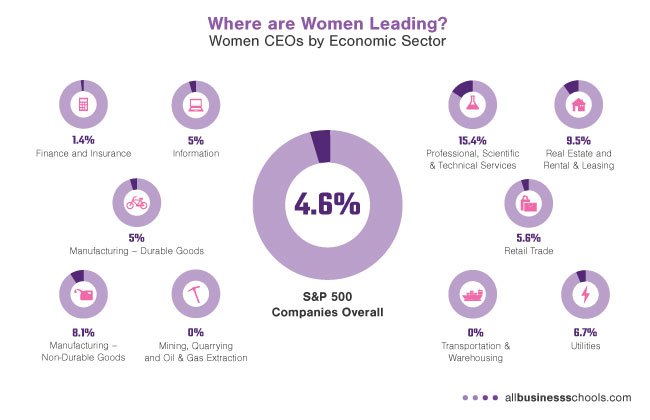
The numbers have hovered at this level for about a decade. As Sheryl Sandberg states in her best-selling Lean In, “While women continue to outpace men in educational achievement, we have ceased making real progress at the top of any industry. This means that when it comes to making the decisions that most affect our world, women’s voices are not heard equally.”
“The blunt truth,” she continues, “is that men still run the world.”
Workplace Sexism: Relic or Reality?
Part of the fun of “Mad Men” was its depiction of the retro office culture that blatantly held women back—even when they had proven they could out-perform their male peers. Things are so much better now. Or are they? While it’s true that the work world has improved enormously for women, and we now have anti-discrimination laws on the books, the statistics don’t lie.
If women are equally as capable as men, why aren’t they represented in equal numbers at the upper echelons of business? Why, as Sandberg notes, are we sourcing leaders from only one half of the population?
One answer, neuroscience suggests, is our deeply entrenched sense of “the way things are supposed to be.” As with those Google images and Hollywood movies, we’re accustomed to seeing men at the top. It seems normal for them to be in charge. When we see an aberration, science suggests, both men and women instinctively balk.
“We are used to seeing men lead and so have an immediate confidence and comfort in what they might do, even if they are less qualified for a job…” says Chanel CEO Maureen Chiquet. “We are not as familiar with women leaders and so we question their skills. As women, we always need to work harder to prove our competence.”
Unconscious Bias: The Silent Player
By and large, men are not deliberately holding women back—but they may do so unwittingly. And they have help in perpetuating the status quo. Contemporary research suggests that both women and men harbor a persistent, unconscious pro-male bias. For example:
- A New York University study found that mothers of infants over-estimate their sons’ crawling abilities and under-estimate their daughters’ abilities.
- Linguist Kiernan Snyder found that women are more likely to be labeled “abrasive” in performance reviews, advised to “let others shine,” and to pipe down. She found no instances in which men were described as abrasive. Rather, they were praised for assertiveness.
- But the pejorative comments weren’t just from men. Managers of both genders stacked the odds against women. Snyder (who has since gone on to create a tool that analyzes text for gender bias and overall tone), admitted that she was guilty of the same tendency before her research revealed her own bias.
- Another study asked professors to evaluate the résumés of two supposed job applicants for a laboratory manager position. One group received a résumé with the name Jennifer at the top; the other received the identical résumé with the name John. Although the content of the documents was identical, the evaluators rated John as more competent and suggested an average starting salary almost $4,000 higher than for Jennifer.
- In the music world, orchestras have dramatically curtailed hiring bias by conducting “blind” auditions in which musicians are concealed behind screens. The practice is credited with a 30-55 percent increase in the number of female musicians hired by professional orchestras since 1970.
We all want to believe that the workplace is a meritocracy in which great work is rewarded with pay and promotion, regardless of the person putting in the effort. But the research shows otherwise. As humans, we all harbor unconscious bias, whether we want to or not. The point is not to blame one group or another, but to raise awareness of the tendencies to which we’re all liable.
Unconscious bias helps explain the lack of women at the upper levels of business: We’re all predisposed to pick teammates who look like us. Since the majority of CEOs are men, it makes sense that they tend to hire other men for leadership positions.
Banishing Bias at Work
“Ending gender inequity is a challenge that involves us all,” says consultant and author Janet Crawford. “We may not be to blame for the problem, but we are all responsible for the solution.”
Ready to start turning the tide? Here are some ways to curtail unconscious bias:
- Speak up when you see it in action. For example, studies prove that both men and women interrupt women more frequently. Rein in an offender by simply saying, “Wait, I want to hear what she’s saying.”
- Experiment with change. Glenn Mazarra, a director with the TV drama The Shield, instituted a no-interruption policy when he noticed that the women writers could barely get a word in edgewise at pitch meetings. He saw the entire writing team become more effective as a result.
- Strike a power pose. Social psychologist Amy Cuddy’s popular Ted Talk demonstrates how body language affects both how others see us, and our own body chemistry. Taking a “Wonder Woman” stance—hands on hips, feet spread wide—for just two minutes can actually elevate testosterone and lower cortisol levels.
- Create a buddy system. Leadership consultant Selena Rezvani champions female support networks, recounting one law firm in which women referred new business leads to each other first, thus improving their performance metrics.
- Share the credit. For women, the communal approach works. Often uncomfortable tooting their own horns, they’ll readily point to each other’s accomplishments.
Crawford chimes in with more great pointers, including these:
- When you attend a conference, pay attention to the number of female and male speakers on stage. Are the speakers mostly male, while women staff the registration desk? Give feedback to conference organizers about the ratios you observe.
- Take a look around your workplace: Are team-building events slanted toward predominantly masculine interests such as fishing or golf expeditions?
- Does your company culture encourage and reward inclusive and collaborative behavior?
Most importantly, educate yourself on the issue of unconscious bias so that you can start noticing your own conditioned responses to the status quo. This column by journalist Nicholas Kristof is a great jumping-off point.
Making the Case: Diversity and Dollars
Encouraging and supporting more women in business leadership roles isn’t just the right or “nice” thing to do. Greater diversity makes a real impact on the bottom line, such as:
- Better Revenue: When women lead businesses with more than 1,000 employees, the per-employee revenue is 18% higher than when men lead the same size businesses.
- New Customer Insights and Markets: Women hold the power of the purse strings. According to the U.S. Women’s Chamber of Commerce, females influence up to 85% of purchasing decisions, wielding economic power that’s estimated at $5 to 15 trillion of total U.S. consumer spending. Businesses with more women calling the shots are better positioned to both predict and meet the demands of their female customers. For example, Campbell’s Soup Company, which has won recognition for its efforts to help women advance their careers, created its Select Harvest line after focusing on women in its research. It was the company’s fastest growing soup line in 2009—developed by women, for women.
- Radical Innovation: A 2014 study reported by Science Daily makes it clear: “Gender diversity within research teams fosters novel solutions leading to radical innovation, in the company and in the market.” With a broader range of perspectives at the table, there are inevitably more ideas and more approaches to any problem-solving process. The result? More innovative solutions to complex problems, whether it’s technology or turkey soup.
Women in the Boardroom
“A real barrier [to female leadership] is the lack of a critical mass of talented women leaders as role models and mentors,” says Goldman Sachs global co-head of securities Isabelle Ealet. What can we do to help turn the tide? One way may be to elect more women to serve on corporate boards of directors.
Boards hold the reins of corporate power. They hire CEOs and pinpoint future leaders. Today, women hold just 27% of the board seats at Fortune 500 companies in 2020—not a stellar number, for certain, but significantly up from 9.6% in 1995.
Here too, gender diversity is good for the bottom line. According to the Anita Borg Institute, Fortune 500 companies whose boards include the sustained representation of at least three women board directors significantly outperform those with no female directors:

But there’s a disconnect between the research and the reality. Women’s participation on boards lags men’s around the world:
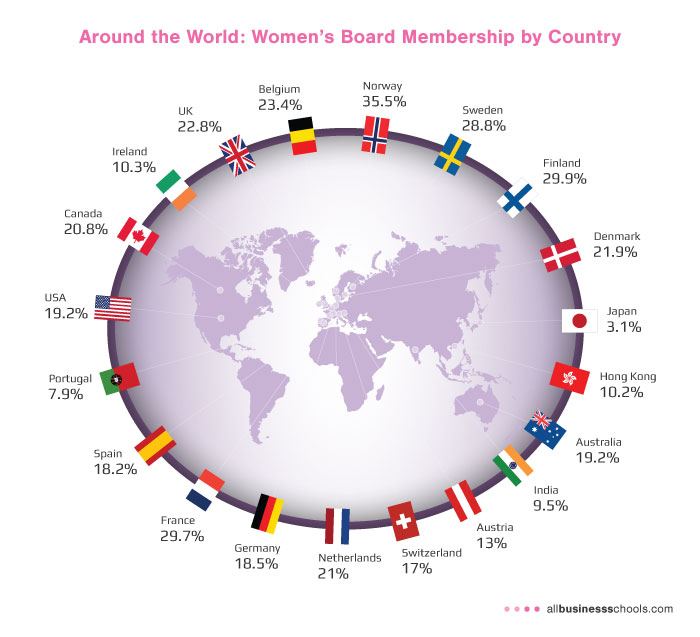
Why are the numbers higher in some countries? Their governments have stepped in. In 2003, Norway passed legislation mandating that women comprise 40% of the boards of public companies. So far, six European countries have followed suit. In the U.S., several companies have joined the 30% Club, an international group that aims to boost female participation on boards to 30%.
For women looking to make inroads to leadership, service on a nonprofit board is great training ground to hone skills, make connections and position themselves for more powerful positions in the workplace.
Not sure where to start? Look into your local Junior League chapter. An international organization of some 150,000 women, it works to boost voluntarism, develop women’s potential and improve communities through trained volunteer leaders.
The Habit of Holding Back
Microsoft CEO Satya Nadella caused a flap when he advised women to avoid asking for raises, suggesting that they instead wait for the recognition to come their way. Although he backed off those statements, many women still take that “sit back and wait” approach, working quietly and hoping that their day will come.
Studies reveal that women are reluctant to apply for positions for which they feel less than 100% qualified. Men, on the other hand, will put themselves forward when they meet roughly 60% of the requirements of a job.
In some regards, women are complicit in maintaining the status quo at work by holding themselves back:
- In study after study, whether it concerns medical students or political candidates, women underestimate their performance (while men tend to overestimate their own). “Many women lack confidence, even though they are talented and qualified for leadership,” laments Wal-Mart’s executive vice president Susan Chambers. “Women are spontaneous confessors and tend to disclose their vulnerabilities first.”
- Women are often reluctant to take a seat at the table—literally. Author Tara Jaye Frank recounts an important lesson she learned at a business meeting with poet Maya Angelou. As seats around the conference table filled up, Frank moved to offer hers to a newly arrived gentleman. Angelou stopped her, telling the twenty-something Frank: “You don’t have to give up your seat to anyone. You are just as worthy of that seat as he is, and you have every right to sit proudly in it.”
- Old habits exact a high price, says leadership consultant Rebecca Shambraugh: “When I see women capable of C-suite leadership mired in middle management, I don’t look toward a glass ceiling. Instead, I look toward a sticky floor. In fact, our most useful insights may come from exploring what keeps us stuck: our outmoded, self-defeating and, let’s face it, unconscious behaviors… I believe we are stuck because of habits we learned years ago.”
Defeating Old Habits
How to unlearn these entrenched habits? Start with a tip from marketing guru Seth Godin, who shares a discovery he made on his high school quiz team: Don’t wait until you’re 100 percent certain you have answer before you hit the buzzer. In that split second, you will have lost the opportunity. Buzz in anyway, he coaches, and trust that the answer will come to you when you open your mouth. If it doesn’t, the penalty you’ll pay is less than the cost of the missed opportunity.
Business leaders offer similar advice to their colleagues, both male and female: Take risks in your career. Go for stretch assignments. Don’t hang out in your comfort zone, doing the same things you’ve done before. Keep your hand up. When you feel yourself hesitating, remember the confidence gap, and dive in anyway.
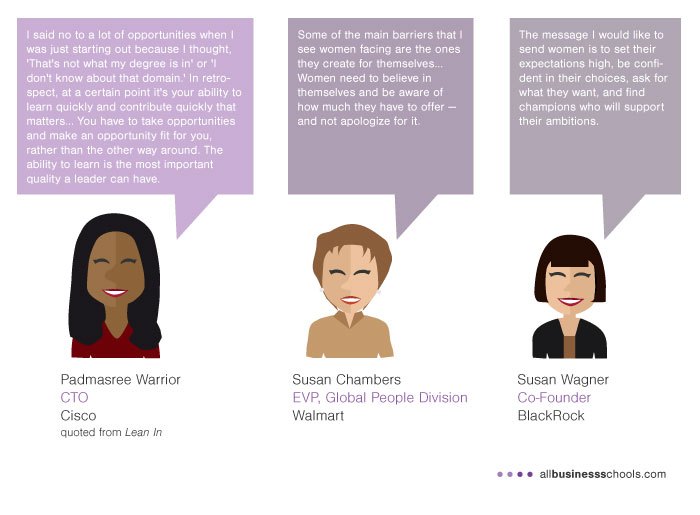
Female Leaders: Myth vs. Reality
Ideas about women and power are tainted with outdated myths about how ruthless, calculating and cold a woman has to be in order to make it to the top. Remember Meryl Streep’s turn in “The Devil Wears Prada?” Or Sigourney Weaver’s backstabbing boss in “Working Girl?” These one-dimensional Hollywood portraits can be fun, but they’re mostly fantasy. Here’s how some of Forbes’ 100 most powerful women in the world are disproving the myths about successful females.

Ice queen

Oprah Winfrey – The media mogul and philanthropist is living proof that warmth and charisma go hand in hand with success.

Single and lonely

Confidence is attractive. The majority of women on the Forbes list are married moms, and they often cite a supportive partner as essential to their success.

Weak

Mary Barra—The first woman ever to lead a Big 8 automaker, Barra braved a 30-million car recall in her first year on the job. Statistically, women are more likely to be called to lead when a company is floundering.

Masculine

Marissa Mayer —The Yahoo! CEO made headlines—and became a role model for millions—when she worked through her pregnancy.

Conniving

Indra Nooyi – By giving a board seat to an unhappy investor, the PepsiCo CEO turned a potential enemy into a close advisor.
The Parent Trap
Speaking of stereotypes, how about the image of the harried working mom, holding a baby under one arm and wielding a briefcase in the other?
There’s a grain of truth in it: Despite decades of social progress, women still handle the lion’s share of home and child care responsibilities. Girls learn from an early age that they’ll have to choose between family and a career. When a couple announce they’re expecting a child, the woman is asked how she’ll handle both work and family; men don’t hear the same questions.
Although they’re getting better at doing dishes and changing diapers, men still perform less than half the housework and child care in U.S. households. Until men and women are contributing equally on both the home and the work fronts, women will be hobbled by the expectation to perform two jobs.
More than one female CEO has stated that the biggest determinant of her success has been a supportive partner. “We are a team, “says Wal-Mart’s Chambers, whose husband ran a business from home while caring for their three kids.” I would not be in this job if I hadn’t had his support.” Sandberg concurs, saying, “Ultimately, it seems that the most critical thing for an ambitious woman is a supportive partner.”
What does that support look like, and how can women get it?
Raquel Fernandez, a New York University professor and author of a study of mothers and sons, offers some cogent advice in an interview with the New York Times. “If you want to work, the best way you might find a supportive environment for that is to marry a man whose mother worked,” she says. Her research shows that these men are more likely to marry women who work outside the home, and to be more supportive of working wives.
Already have a partner in place? Women can still achieve a 50-50 share of household and parenting responsibilities by initiating some changes, including:
- Advocate for equal, paid paternity leave at work
- Negotiate with your partner to do fully half of the parenting and housework
- Accept that dad will approach tasks differently than mom
- Let go controlling how the work and parenting gets done
In other words, women, there’s more than one way to load the dishwasher. Let your partner make contributions in his own way, and start noticing—and appreciating—the payoffs in time, energy and household harmony.
Family Leave & Women’s Wages
A woman’s choice of partner is arguably more crucial to her success in the U.S. than just about anywhere else. Along with Papua New Guinea, it’s the only country in the world that mandates no paid family leave—whether for moms or for dads.
Here’s how countries around the world handle government-supported time off for new parents:
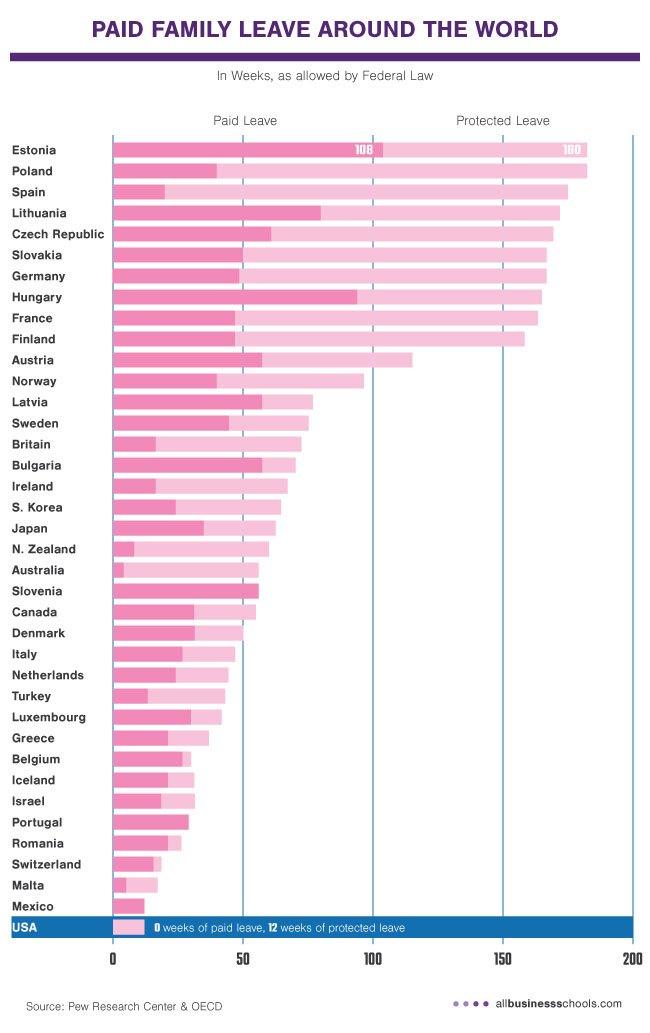
Family leave doesn’t just promote parent-child bonding; it’s a boon for women’s long-term financial security. As reported by the New York Times, “Paid leave raises the probability that mothers return to employment later, and then work more hours and earn higher wages.” A woman faces a steep penalty for taking time out of the workforce: Her earnings decline by about 20% if she’s out of work for one year. After two to three years, the decline hits 30%.
Gender bias cuts both ways. How often are men celebrated for staying home to raise children? More time with dad is good for the kids, and it’s good for women’s careers as well. “When childcare responsibilities fall exclusively on the mother, the effect is to depress women’s wages…” says the Economist. “These days, more governments are starting to believe that the best way to improve women’s career prospects is instead to turn to the dads.”
Working Moms: Drop the Guilt
It can be painful for a woman to leave her kids at daycare and head to the office. Then there’s the hit to her wallet. The cost of childcare jumped more than 70% between 1985 and 2011, according to the Pew Research Center.
But the investment may be well worth it—not just for mom, but for her kids, too. By staying in the workforce, a woman both maintains her earning power and serves as a powerful role model to her children:
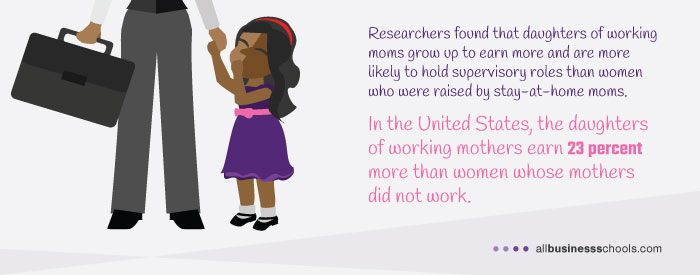
“This is as close to a silver bullet as you can find in terms of helping reduce gender inequalities, both in the workplace and at home,” says study co-author Kathleen McGinn.
Three Powerful Working Moms
Moms, if you’re looking for a role model of your own, Working Mother magazine has found 50 of them for you already. In addition to having high-octane careers, these women all have children under age 18 at home. Some notables from the list include:
Gisel Ruiz, EVP, Walmart International
Children: 2
Ruiz started at the retailing giant in 1992 as a store management trainee and rose to the corridors of power through decades of hard work. Reflecting on her success, she’s eager to pay it forward: “Looking back, there were so many people in my career who chose to help me, who chose to support me, and took the time to do that because they had an interest in me. It’s more of a personal responsibility than a professional one. It really is about giving back…”
Shonda Rhimes, Producer/Writer
Children: 3
Rimes is the creative force behind not one, not two, but three hit television shows: “Grey’s Anatomy,” “Scandal,” and “How to Get Away with Murder,” and Netflix's highest viewed series, "Bridgerton." In her speech at the 2014 Dartmouth College commencement, she delivered a rallying call to her young audience:
“I want my daughters to see me and know me as a woman who works. I want that example set for them. I am a better mother for it. The woman I am because I get to run Shondaland, because I get to write all day, because I get to spend my days making things up, that woman is a better person —and a better mother. Because that woman is happy. That woman is fulfilled. That woman is whole.”
Beyoncé, Actress/Musician/Producer
Children: 1
The music industry’s highest earning woman, Queen Bey is also a savvy businessperson, pop culture icon and the woman President Obama called an ideal role model for his daughters. “We have to teach our boys the rules of equality and respect,” she says, “so that as they grow up gender equality becomes a natural way of life. And we have to teach our girls that they can reach as high as humanly possible.”
The Time Has Come
Back in 1978, James MacGregor Burns coined the phrase “transformational leadership,” describing a process in which leaders and followers raise each other to “higher levels of motivation and morality.” By focusing on substance, he suggested, transformational leaders improve the level of human conduct and ultimately empowers others.
“It’s a way of conceptualizing power that women are particularly suited to and adept at using,” says former Planned Parenthood director Gloria Feldt in No Excuses. Whether this ability stems from socialization, brain structure, or something else, women are moving away from the old leadership paradigm. Instead of controlling others and getting them to do what you want, explains Feldt, transformational leadership is about creating consensual, inclusive relationships that focus on collaboration and mutual empowerment.
Recent global research points to evolving attitudes about power. John Gerzema and his colleague, Michael D’Antonio, surveyed tens of thousands of people for their book, The Athena Doctrine. Their study uncovered a growing dissatisfaction with traditionally “male” approaches to business and a “growing appreciation for the traits, skills and competencies that are perceived as more feminine.”
In a survey of 64,000 people in 13 counties around the globe, they found that:
- 57% of the respondents were dissatisfied with the conduct of men in their country
- 80% of millennial generation respondents were dissatisfied with the same
What’s more, two thirds of survey respondents—both men and women—agreed with the statement that, “The world would be a better place if men thought more like women.”
But how do women around the world think, anyway? And how does this thinking apply to leadership?
To find out, the researchers asked half of their sample (32,000 people globally) to classify 125 different character traits—descriptors such as loyal, decisive, collaborative—as either feminine, masculine or neither. Next, they asked the other half of their sample to rate the same words (independent of gender) for their relationship to leadership. When the researchers crunched the data, says Gerzema, there was consensus: “…what people felt was ‘feminine’ they also deemed essential to leading in an increasingly social, interdependent and transparent world.”

But these characteristics aren’t exclusive to women. Anyone can incorporate them into an effective leadership approach. In The Athena Doctrine, Gerzema recounts the stories of dozens of men and women doing just that, from a (male) scientist who dropped the mask of “supreme competence” when he created a social network for thousands of his peers, to a woman who recruits grannies to become professional knitters.
“The resounding message we learned from our research—both empirical and anecdotal—is that in this open, social, interdependent economy, leaders need to evolve,” says Gerzema. “They still need to be aggressive, resilient, decisive and all those more male-associated qualities that leaders are known for, but they also need to build in more of the feminine qualities such as empathy, transparency, collaboration, selflessness and passion.”
If Gerzema is right, the world is hungry for a new style of leadership—one that’s less Lehman Brothers and more “lean in,” less adversarial and more adept at navigating a changing, interconnected future.

